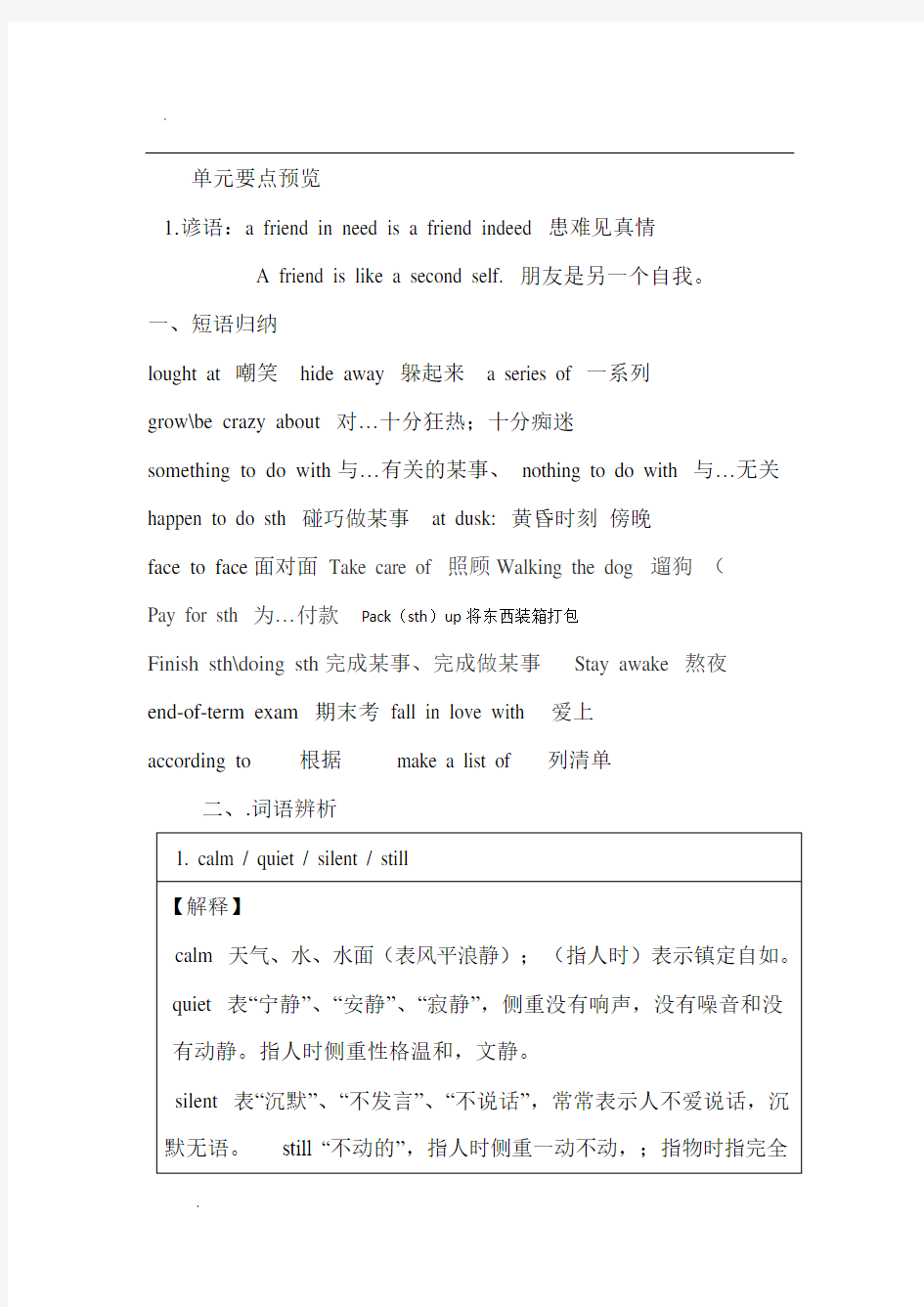

单元要点预览
1.谚语:a friend in need is a friend indeed 患难见真情
A friend is like a second self. 朋友是另一个自我。
一、短语归纳
lought at 嘲笑hide away 躲起来 a series of 一系列
grow\be crazy about 对…十分狂热;十分痴迷
something to do with与…有关的某事、nothing to do with 与…无关happen to do sth 碰巧做某事at dusk: 黄昏时刻傍晚
face to face面对面Take care of 照顾Walking the dog 遛狗(
Pay for sth 为…付款Pack(sth)up将东西装箱打包
Finish sth\doing sth完成某事、完成做某事Stay awake 熬夜
end-of-term exam 期末考fall in love with 爱上
according to 根据make a list of 列清单
二、.词语辨析
四.重点词汇
1. upset adj. 心烦意乱的,不安的;不适的vt. (upset, upset)
Don't upset yourself -- no harm has been done. 不要难过--并没有造成伤害。
2. concern v.担忧; 涉及; 关系到n. 担心,关注;(利害)关系[重点用法]
as / so far as … be concerned 关于;至于;就……而言
be concerned about 关心
be concerned in sth. 牵涉到,与……有关,参与
3. settle vt. 安家;定居;停留vt. 使定居,安家;解决
1). The family has settled in Canada. 这家人已定居加拿大。
2)Try your best to calm yourself down..
[重点用法]
settle down 镇定下来settle in 在…定居
4. suffer vt.& vi.遭受;忍受;经历
Do you suffer from headaches? 你常头痛吗?
suffer from 感到疼痛﹑不适﹑悲伤等; 受苦; 吃苦头:
5. disagree vt. 不同意disagree with sb 不同意某人的观点
. Even friends sometimes disagree with each other. 即便是朋友也有时意见不一。
五.重点词组
1. add up 加起来
Add up your scores and see how many points you can get.
把你的得分加起来,看看你能得几分。
add (…) to ….把什么)加入…中add up to …加起来是add to 增加[练习] 用add的适当形式或构成的词组填空
1). Will you _____ some more students to this project?
2). Small numbers _____ a large one.
3). 50 _______ 50 equals 100.
答案: 1). add 2). add up to 3). added
2. go through 经历;经受
[短语归纳]
go after追求,追赶go ahead前进;请说(做)吧
go by走过,(时间)过去go along with向前,(与……)一起去go in for爱好,从事go out外出;(灯,火)熄灭
go over越过;复习go up爬上,(价格等)上升
go home 回家go to bed 上床睡觉
3.on purpose 故意,有目的地
[短语归纳]
do sth. on purpose: 故意做某事on purpose 表示故意地、有企图、有目的地
4. get along with 与某人相处;(工作的) 进展
1) He is not easy-going. It’s very hard to get along with him 他不是个
随和的人,很难相处。
2). How are you getting along with your work? 工作进展如何?
[短语归纳]
get along/on well / badly with 与……相处得好/不好,……进展顺利/不顺利
get away离开,逃离get down下来;写下,取下
get down to (doing)开始认真干……get over克服,摆脱
get through通过,做完get together聚集
5. in order to… 为了……(可置于句首或句中)
She arrived early in order to get a good seat. 她到得很早, 图的是得个好座位。
[短语归纳] so as to为了……(只能置于句中,不能置于句首)in order that…以便(后跟句子)so that…以便(后跟句子)
6share sth. with sb. Vt. 分享,分担
短语:E.g. She always shares happiness and worries with me.
7. No longer\ not…any longer 不再
?If you are always dishonest, people will no longer believe you.
如果你老是言过其实,人们就不会相信你了。
8 Get \be tired of 对…厌烦
be tired with 对…到疲倦
You may be tired with reading, but you should not be tired of it.
9 should have done 本应该。。shouldn’t have done
表示过去应该做某事而实际上没有做
E.g You should have come her five minutes ago.
E.g You shouldn’t have told him about this.
六.重点句子(旨在提供句子结构等所需材料)
1. Mom asked her if (whether) she was very hot with so many clothes on. 妈妈问她穿那么多衣服是不是很热。
[解释] with复合结构:
with + 宾语+ v. –ing / v. –ed / to do / adj. / adv. / prep. phrases
由“介词with+宾语+宾语补足语” 构成的复合结构在句中通常作为状语,表示背景情况,为方式,原因或条件等,另外,该结构也可以作为定语使用。下面简述几种情况:
1) 如果在该结构中的分词表示的动作是由前面的名词或代词发出的,构成主谓关系,即主动和进行,该分词用现在分词形式。
2) 如果分词表示的动作与前面的名词或代词构成动宾关系,即被动,该分词用过去分词形式。(被动)
3) 宾语补足语也可以使用介词短语,形容词或副词来充当,表状态[典例]
1.with + 宾语+ 副词,如:
The square looks more beautiful with all the lights on
2.with + 宾语+ 介词短语,如:
The teacher came in with a book in his hand
3.with + 宾语+ 现在分词,如:
With the teacher standing beside ,she felt a bit uneasy.
4.with + 宾语+ 过去分词,如:
With the work done , she felt greatly relieved.
5.with + 宾语+ 不定式,如:
With Mr Smith to teach them English next term , they will be greatly improved in spoken English.
2. I don’t set down a series of facts in a diary as most people do … 我不愿意像大多数人那样在日记中记流水帐……
[解释] as引导的从句为比较状语从句,意为“像大多数人那么做”。
as 用作连词,可引导下列状语从句:
1). 引导状语从句,强调主句谓语动词与从句谓语的同时性,伴随着。。
As he grew older he lost interest in everything except gardening.
随着他年纪越来越大,他失去了对所有事物的兴趣,除了园艺。
2). 引导让步状语从句,表示“尽管,虽然,即使”(从句需倒装)
Cold as it is, my brother wears only a shirt. 尽管天气冷,我哥只穿了一件衬衫。
3). 引导方式状语从句,表示“以……方式”。